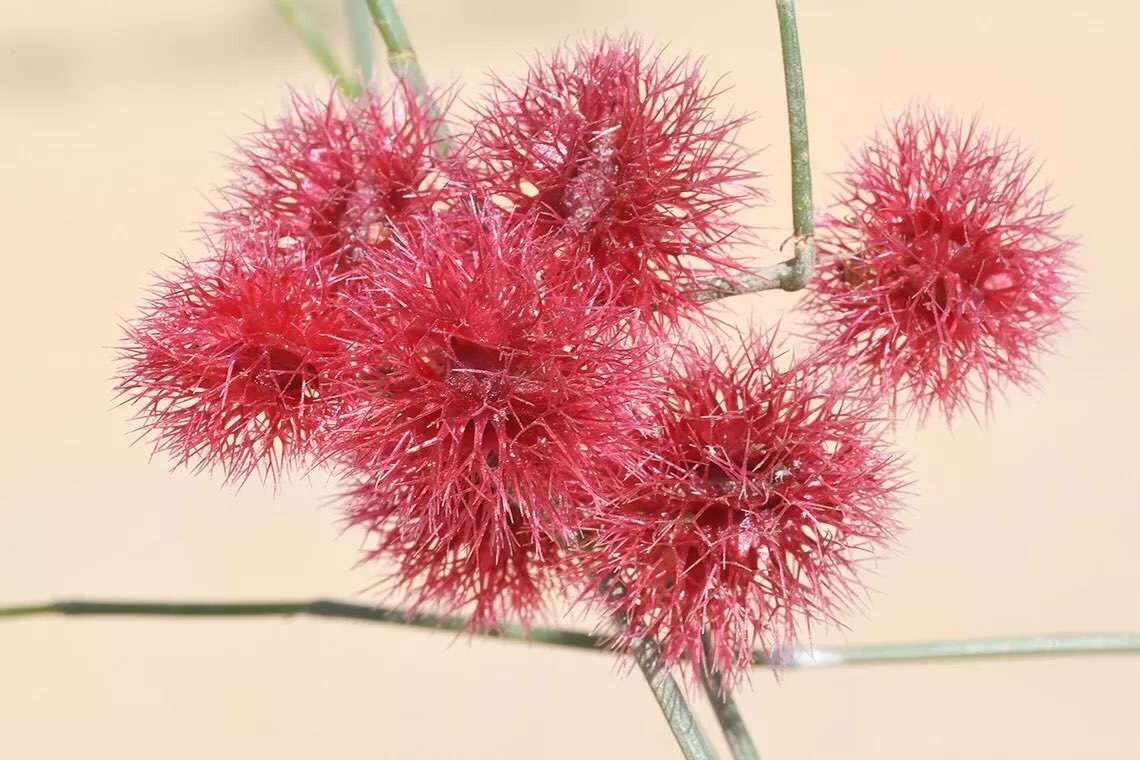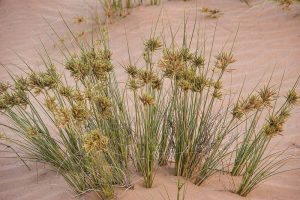Calligonum comosum, commonly known as “Arta”, is a hardy desert shrub native to the Arabian Peninsula, including Kuwait. This drought-resistant plant is a cornerstone of the desert ecosystem, renowned for its resilience in harsh conditions and its vital role in combating desertification.
🌱 Key Characteristics
- Appearance:
Arta is a sprawling shrub that grows up to 2 meters tall. It features slender, jointed green stems and tiny, scale-like leaves that minimize water loss. During its blooming period, the plant produces small, cream-colored to pinkish flowers that stand out against the arid landscape. - Adaptations to Harsh Environments:
- Deep, extensive root systems enable it to access underground water sources.
- Efficient water storage and reduced transpiration allow it to thrive in extreme heat and low rainfall.
🌵 Ecological Importance
- Soil Stabilization:
Calligonum comosum plays a crucial role in anchoring sandy soils, preventing wind erosion, and slowing desertification. Its presence helps maintain the structure of fragile desert landscapes. - Habitat for Wildlife:
The plant provides shelter and a food source for insects, birds, and small mammals, contributing to desert biodiversity. - Resource for Livestock:
In times of scarcity, its stems and foliage serve as emergency fodder for camels and goats, demonstrating its ecological and practical value.
🌠Cultural and Traditional Uses
- Fuel Source:
Historically, Arta wood has been used by Bedouins as a reliable source of fuel due to its ability to burn efficiently, even when fresh. - Medicinal Uses:
Extracts from Calligonum comosum are known in traditional medicine for their anti-inflammatory and antimicrobial properties. They are sometimes used to treat minor wounds and digestive issues.
âš ï¸ Challenges and Threats
Despite its resilience, Calligonum comosum faces several threats:
- Overgrazing: Excessive livestock feeding can deplete plant populations.
- Urban Expansion: The destruction of natural habitats due to development projects.
- Climate Change: Shifting rainfall patterns and rising temperatures put additional pressure on this species.
🌱 Conservation Tips for Calligonum comosum
- Promote Sustainable Grazing:
Work with local herders to establish rotational grazing practices to prevent overexploitation of Arta shrubs. - Revegetation Projects:
Use Calligonum comosum in desert greening initiatives to restore degraded lands and stabilize sandy soils. - Protect Natural Habitats:
Advocate for the establishment of protected areas where native plants like Arta can thrive without human interference. - Community Education:
Raise awareness about the ecological importance of Arta and encourage its preservation among local communities. - Research and Monitoring:
Support scientific studies to better understand the plant’s role in desert ecosystems and its response to environmental changes.
At Nowair Kuwait Agriculture Services, we believe that protecting native plants like Calligonum comosum is essential for a sustainable future. By implementing smart conservation practices and raising awareness, we can safeguard this remarkable plant and the ecosystems it supports. Let’s work together to preserve Kuwait’s desert heritage. ðŸŒ




